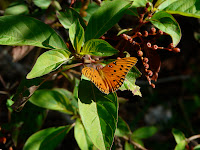Native Plants - Not Everybody Likes Them
And now for something else completely different. Occasionally it comes to our attention that not everyone likes native plants. This fall, I shared with some people from my FNPS chapter a link to an article telling about some new research that Doug Tallamy is doing. You may remember him as the author of Bringing Nature Home. After he had read the new article, I received this reply from a chapter member who had recently started his own landscaping business.
Hi Sue, I really enjoyed this article. The two researchers, Tallamy and Bruck, have discovered exactly what I have discovered in the last two years since starting Sustainscape, Inc., I have made it my model to take on customers who are not necessarily interested in going native, but who have an “open mind.” I have learned that their mindset changes through time, and the more I am patient with them, the more they begin to be patient with their landscape. The open-mindedness part is the most important. I have to follow their rules in the beginning in order to gain their trust. Many times I am asked to provide exotic plants; however, every design I create is at least 50% native, and none of the exotics are invasive. I do not plant invasives or use chemicals like roundup or atrazine. When I have taken on the risk of taking a new customer without the Sustainability or Native knowledge, it has been more challenging. I have a total of three customers who would not, or have not, decided to have an open mind. Two of these customers I dropped and the other I just count as a “bronze” level customer. If they cannot have an open mind to the methodologies (no chemicals, reduced fertilizers, more natives, etc.) that I try to promote, I generally lose money from them and it does not make business sense to keep them. However, many of the best customers I have taken on are completely oblivious/uncaring about natives and the harmful effects of fertilizers. The more I show them how it works, the more their mind set changes. It truly gives me satisfaction when this happens!!
My point, which is the same as the articles’ (in my perspective), is the more open-minded we are as native plant lovers, the more open-minded the public will be and eventually change the psychology.
Dennis de Zeeuw
Now that is what I call a good story! Dennis, we can all appreciate your sustainable work, and learn from your thoughtful example. We all need to be educating people about the value of native plants with the patience and open-mindedness that has proven so successful for you. We can also rejoice in the fact that the message really is getting out there these days. Look at this new book, featured over on our friend's beautifulwildlifegarden.com blog: Garden Design with Indigenous Plants
Here's the article about Doug Tallamy mentioned above: Researchers Promote Native Plants
Haven't read Bringing Nature Home yet? Click it over in the sidebar to the right and Bring It Home.
Got a story about your business you'd like to share? Bring It Here.
sue dingwell





Comments
Thanks for the link to "Garden Design with Indigenous Plants" - I'm going to check that out.
"All the yards that i have seen that are fl.freindly certified are ugly .they look unkept and bland They dont have the beauty that other yards have with azealas palms and other non native plants. have native plants look ok in the woods but are a waste of money to try to use in the home landscapes."
And this one:
"Green is the new Red: The green movement is controled by the Eco Marxist. the native plant societies are just a arm of liberal groups like the Sierra Club Green Peace. To find out the truth go to climate depot.com"
I am of the "use what you need and leave the rest to nature" school, as my husband wants some lawn in our yard. He's the first to admit, though, that he loves the shade, the privacy, and the low maintenance of our native trees and shrubs. I enjoy those benefits - but also love the increased numbers of birds, butterflies, and the occasional oppossum.
--Penny
Unfortunately, jacksonville.com does not have a delete function, but I continue to post articles and comments to educate people about native plants, sustainable gardening and saving water. I'll put up with the negativism to try to get through to others.